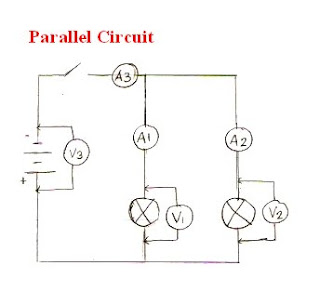April 21,2009Measuring Current, Voltage, and Resistance in Series and Parallel Circuits Block D
Purpose: To determine patterns and formulas to predict current, voltage, and resistance in series and parallel circuits.
Procedure: As described in BC Science 9 p. 314-315 + calculations for resistance
Data and Observations:



Questions:
1. In a short paragraph, explain how current and voltage change in a series circuit.
The voltage in a series circuit is different. The first bulb and the second bulb, when their voltages are added together, it forms the voltage of the battery. Also, one of the bulbs have more voltage than the other bulb. Current in a series circuit is the same throughout.
2. In a short paragraph, explain how current and voltage change in a parallel circuit.
The current in a parallel circuit is different in each area. The wires in which the electrons flows first gets the most current. The middle wire, or A1 above, has the lowest current. The last wire, or A3 above, has the most current. Voltage in a parallel circuit is the same throughout.
3. What do you notice about resistance in series? Do you notice an obvious pattern for resistance
in parallel?
There's a lot more resistance in series than in a parallel circuit. In parallel, I notice that when you multiply the value of V3/A3 by 2, you can almost get the value of V1/A1.
(Actually, I'm not really sure of what I'm writing, but there are my observations.)
Conclusion:
I learned in series circuits that the current stays the same throughout, while the voltage stays the same throughout parallel circuits. Also, here are some patterns that I learned.
In series,
V1 + V3 = V2 or in words, the voltage of two light bulbs equals the voltage of the battery.
In parallel,
A1 x 2 = almost A3 or in words, the current in the middle wire multiplied by two is almost the value of the current near the switch.
The value of V3/A3 multiplied by 2 is almost the value of V1/A1.
Tuesday, April 21, 2009
Measuring Current, Voltage, and Resistance in Series and Parallel Circuits
Posted by Julie Anne at 7:42 PM 1 comments
Saturday, April 18, 2009
Lab 9-1A: Turn Out the Lights
April 18, 2009 Turn Out the Lights Julie Anne A., Block D
Purpose: To gain an understanding of the flow of electrons in a circuit.
Procedure: As described on p. 307 of BC Science 9
Data and Observations:
Circuit 1
Circuit 2
Questions:
1. I'm an electron leaving the negative terminal of the cell in circuit 1.
- There is only one way for me to get to the positive terminal of the circuit.
- I need to travel through two light bulbs.
2. When one bulb is removed in the circuit, the other bulb becomes unlit. This happens because everything in the circuit is connected together. If a bulb is unscrewed, the flow of electrons will be cut off because one of the elements where the electrons will travel and be passed on is disconnected. Because of that, the electrons will not reach the other bulb.
3. I'm an electron leaving the negative terminal of the cell in circuit 2.
- There are two ways for me to get to the positive terminal.
- I need to travel through two light bulbs.
4. In circuit 2, when one bulb is removed, the other one is still lit. This happens because each of the bulbs are directly connected to the battery. When one is unscrewed, it doesn't affect the direct connection of the other bulb in the battery. This is why the other one is till lit.
Conclusion:
In this lab, we confirmed the flow of electrons in a circuit by observing light bulbs.
In circuit I, when the other bulb is unscrewed, the other one turns off because the light bulb acts as a sort of switch, since everything in the circuit is connected. The unscrewing of a material will break the circuit and the flow of electrons. Also, when the two bulbs were connected in the circuit, the other one is very dim because there is not enough potential difference. When the electrons get out of the negative terminal, the first bulb it goes through recieves the most electrons and the other one recieves a little due to the lack of potential difference.
In circuit 2, when the other bulb is unscrewed, the other one is still lit because each bulb has a direct connection with the battery. This is also the reason why both of the bulbs are brightly lit. (Notice that in circuit 1, two light bulbs are connected to the battery, indirectly. Both of them has to share the potential difference of the battery in one flow of the electrons.)
This explains why circuit 1 could not light both lights.
Posted by Julie Anne at 10:14 AM 2 comments
Friday, April 17, 2009
Green Bricks Project (To be posted)
Our class created a project in which our task was to brainstorm ideas that will help green a part in our community or home. My group, Sara, Annalise, Nataly, Mary and I chose to do our project on batteries. Batteries are very common everywhere but they don't get disposed properly. Most people just throw them in their garbage as one of their household trashes. However, disposing batteries unproperly can harm the environment. The acidic content of the batteries can leak through the ground and can flow through a body of water where it will affect the aquatic animals.
Posted by Julie Anne at 10:15 PM 1 comments







